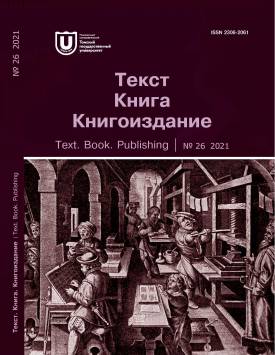Age Rating of Books and Readability: On the Correlation of Two Indices
The article examines the correlation of two indices characterizing the level of linguistic or semantic complexity of the book content. The first index is the age rating in accordance with the Russian Age Rating System for information products. The second index is the ease of understanding of the text, calculated based on the common readability metrics. The author compares the values of readability metrics for texts with different age rating scores. The experiments were carried out on the collection of 5,516 book previews collected by the author of the article. The previews used are freely available in electronic libraries, and they have age rating scores obtained from their publishers. In accordance with the system adopted in the Russian Federation, age rating scores characterize the book’s targeting to the following age categories: 0+, 6+, 12+, 16+, and 18+. In most cases, the size of the book preview is 10% of the full text, which makes it possible to calculate readability indices. The collected texts were scored according to five commonly used readability metrics: Flash-Kincaid Index, Coleman-Liau Index, ARI Index, SMOG Index, and Dale-Chell Formula. As a result of the readability assessment for the texts of each age category, the author obtained recommended levels of education necessary for their understanding. The obtained values were averaged within the age category and analyzed. The results of the experiments allow asserting that in most cases there is a direct relationship between the age rating score of the book and the expected level of education required to understand it. Moreover, readability scores in accordance with all the considered metrics are directly proportional to age rating scores for age categories from 0+ to 16+. The readability scores of books in the 18+ category roughly correspond to children’s literature, which is apparently explained by the genre characteristics of the books marked by the 18+ label. First of all, the results obtained indicate the adequacy of the existing approach to assessing the book age rating in terms of attributing the text to the target audience by age. Secondly, the relationship between readability indices and age rating scores allow using the values of readability metrics as text features in various computational linguistics tasks aimed at text addressee prediction.
Keywords
computational linguistics,
age content classification,
readability,
text difficulty,
addressee of literary text,
Russian language,
addressee factor,
text corpus,
age restrictionsAuthors
| Glazkova Anna V. | Tyumen State University | anna_glazkova@yahoo.com |
Всего: 1
References
Глазкова А.В. Подход к проведению классификации текстов на основании возрастных групп их адресатов // Труды СПИИРАН. 2017. № 3 (52). С. 51-69.
Nord C. What do We Know About the Target-Text Receiver? // Investigating Translation: Selected papers from the 4th International Congress on Translation. Barcelona : Benjamins Translation Library, 2000. P. 195-212.
Стернин И.А. Фактор адресата в речевом воздействии // Вестник Воронежского государственного университета. Сер. Филология. Журналистика. 2004. № 1. С. 171-178.
Apfelthaler M. Stepping into others’ shoes: a cognitive perspective on target audience orientation in written translation // Monografias de Traducci on e Interpretacio. Valensia, 2014. P. 303-330. Возрастной рейтинг книжной продукции и уровень удобочитаемости 139
Сабурова Н.А., Кириченко А.В. Фактор адресата в детской дидактической поэзии // Язык и культура: вопросы современной филологии и методики обучения языкам в вузе : материалы науч.-практ. конф. Хабаровск : Тихоокеанский гос. ун-т, 2015. С. 261-270.
Ефремова Н.В. Фактор адресата - обязательный вектор дискурсивной деятельности адресанта медицинского текста // Филологические науки. Вопросы теории и практики. 2015. № 5-2 (47). С. 56-58.
Потапова Н.В., Каменева В.А. Возраст адресата - фактор, определяющий структурные, языковые и темпоральные особенности организации новостных гипотекстов // Политическая лингвистика. 2018. № 4 (70). С. 130-136.
Шабанова В.В. Концептуальная организация медиатекста и фактор адресата (на материале текстов национальной тематики) // Политический дискурс в парадигме научных исследований: материалы международной научно-практической конференции. Тюмень : ВекторБук, 2016. С. 92-98.
Щепилова А.В., Сулейманова О.А., Фомина М.А., Водяницкая А.А. Учет фактора адресата в современном образовательном дискурсе // Вестник Московского городского педагогического университета. Сер. Филология. Теория языка. Языковое образование. 2017. № 3 (27). С. 68-82.
О защите детей от информации, причиняющей вред их здоровью и развитию : федеральный закон № 436-ФЗ : [принят Гос. Думой 21.12.2010; одобрен Советом Федерации 24.12.2010]. URL: https://base.garant.ru/12181695/
Collins-Thompson K. Computational assessment of text readability: a survey of current and future research // ITL-International Journal of Applied Linguistics. 2014. Т 165, № 2. P 97-135.
Kincaid J.P. et al. Derivation of new readability formulas (automated readability index, fog count and Flesch reading ease formula) for navy enlisted personnel // Naval Technical Training Command Millington TN Research Branch. 1975. 49 p.
Coleman M., Liau T.L. A computer readability formula designed for machine scoring // Journal of Applied Psychology. 1975. № 2. P. 283.
Senter R.J., Smith E.A. Automated readability index. AMRL TR. 1967. 14 p.
McLaughlin G.H. SMOG grading-a new readability formula // Journal of reading. 1969. № 8. P 639-646.
Dale E., Chall J.S. A formula for predicting readability: Instructions // Educational Research Bulletin. 1948. Vol. 27. P 37-54.
Оборнева И.В. Математическое моделирование классификации объектов (на примере определения категории потенциальных адресатов текста) : автореф. дис.. канд. пед. наук. М., 2006. 18 с.
Оценка читабельности текста. URL: http://readability.io/ (дата обращения: 18.09.2020).
Solnyshkina M., Ivanov V., Solovyev V. Readability Formula for Russian Texts: a Modified Version // Mexican International Conference on Artificial Intelligence. Cham : Springer, 2018. С. 132-145.

